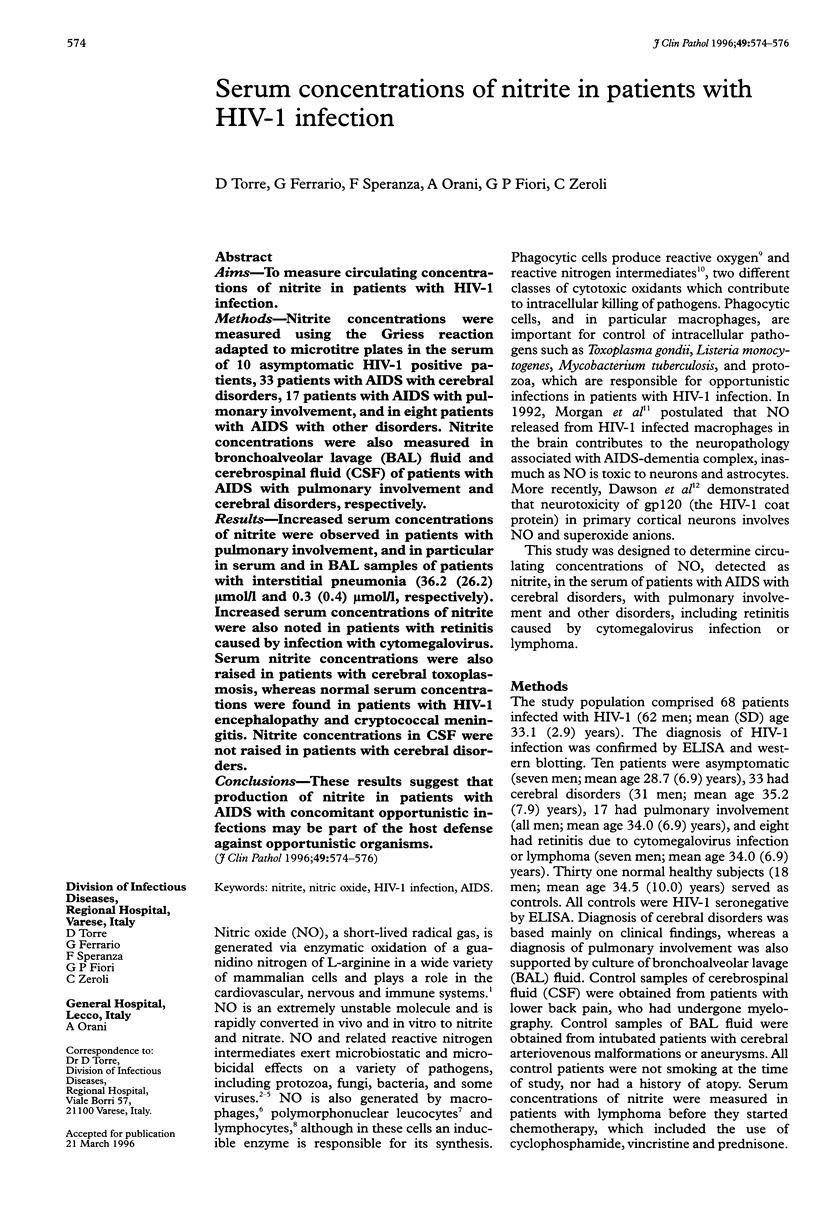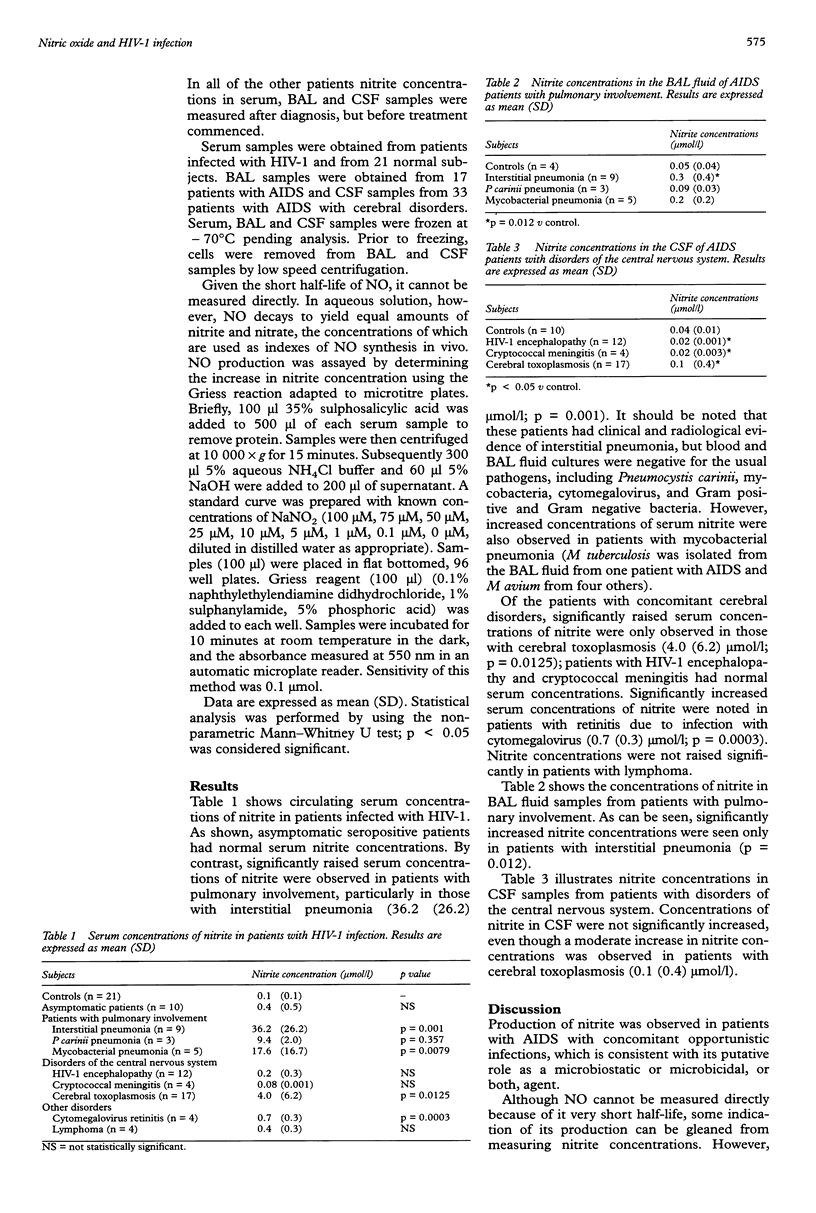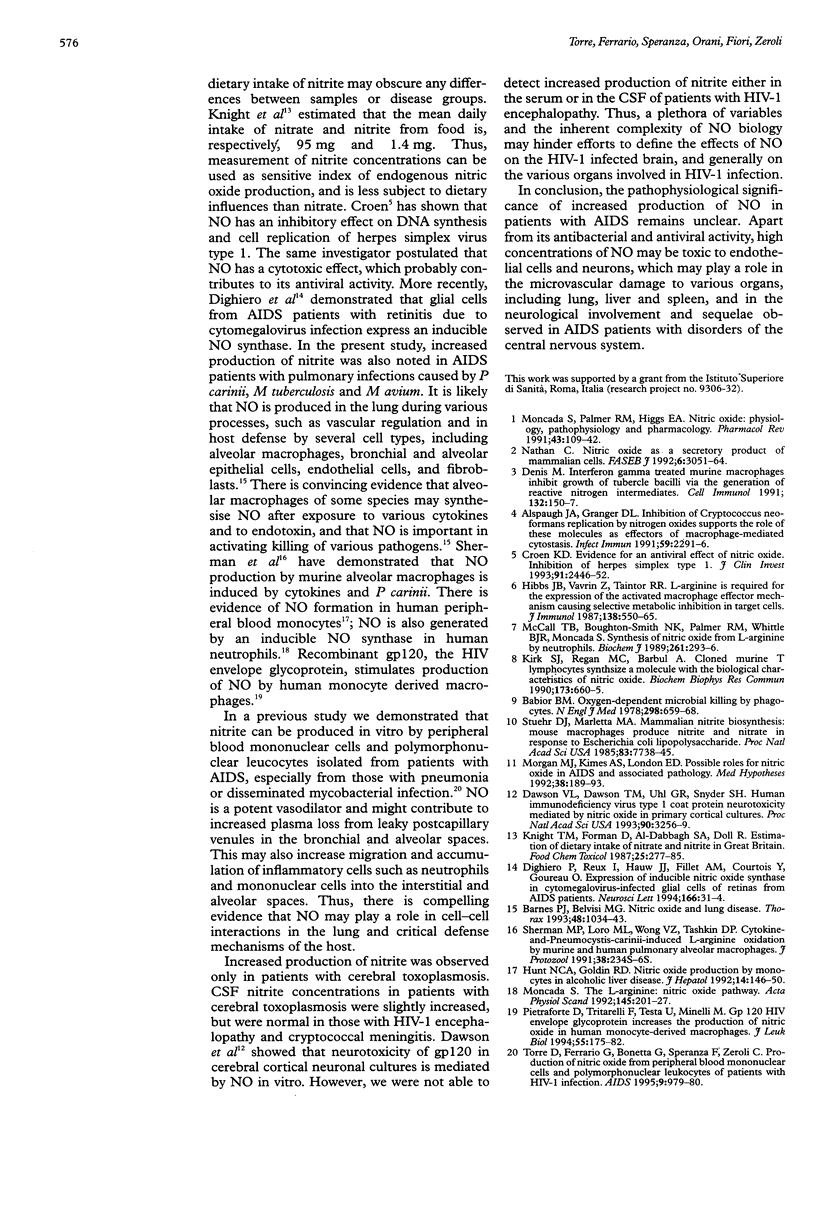Abstract
AIMS: To measure circulating concentrations of nitrite in patients with HIV-1 infection. METHODS: Nitrite concentrations were measured using the Griess reaction adapted to microtitre plates in the serum of 10 asymptomatic HIV-1 positive patients, 33 patients with AIDS with cerebral disorders, 17 patients with AIDS with pulmonary involvement, and in eight patients with AIDS with other disorders. Nitrite concentrations were also measured in bronchoalveolar lavage (BAL) fluid and cerebrospinal fluid (CSF) of patients with AIDS with pulmonary involvement and cerebral disorders, respectively. RESULTS: Increased serum concentrations of nitrite were observed in patients with pulmonary involvement, and in particular in serum and in BAL samples of patients with interstitial pneumonia (36.2 (26.2) mumol/l and 0.3 (0.4) mumol/l, respectively). Increased serum concentrations of nitrite were also noted in patients with retinitis caused by infection with cytomegalovirus. Serum nitrite concentrations were also raised in patients with cerebral toxoplasmosis, whereas normal serum concentrations were found in patients with HIV-1 encephalopathy and cryptococcal meningitis. Nitrite concentrations in CSF were not raised in patients with cerebral disorders. CONCLUSIONS: These results suggest that production of nitrite in patients with AIDS with concomitant opportunistic infections may be part of the host defense against opportunistic organisms.
Full text
PDF


Selected References
These references are in PubMed. This may not be the complete list of references from this article.
- Alspaugh J. A., Granger D. L. Inhibition of Cryptococcus neoformans replication by nitrogen oxides supports the role of these molecules as effectors of macrophage-mediated cytostasis. Infect Immun. 1991 Jul;59(7):2291–2296. doi: 10.1128/iai.59.7.2291-2296.1991. [DOI] [PMC free article] [PubMed] [Google Scholar]
- Babior B. M. Oxygen-dependent microbial killing by phagocytes (first of two parts). N Engl J Med. 1978 Mar 23;298(12):659–668. doi: 10.1056/NEJM197803232981205. [DOI] [PubMed] [Google Scholar]
- Barnes P. J., Belvisi M. G. Nitric oxide and lung disease. Thorax. 1993 Oct;48(10):1034–1043. doi: 10.1136/thx.48.10.1034. [DOI] [PMC free article] [PubMed] [Google Scholar]
- Croen K. D. Evidence for antiviral effect of nitric oxide. Inhibition of herpes simplex virus type 1 replication. J Clin Invest. 1993 Jun;91(6):2446–2452. doi: 10.1172/JCI116479. [DOI] [PMC free article] [PubMed] [Google Scholar]
- Dawson V. L., Dawson T. M., Uhl G. R., Snyder S. H. Human immunodeficiency virus type 1 coat protein neurotoxicity mediated by nitric oxide in primary cortical cultures. Proc Natl Acad Sci U S A. 1993 Apr 15;90(8):3256–3259. doi: 10.1073/pnas.90.8.3256. [DOI] [PMC free article] [PubMed] [Google Scholar]
- Denis M. Interferon-gamma-treated murine macrophages inhibit growth of tubercle bacilli via the generation of reactive nitrogen intermediates. Cell Immunol. 1991 Jan;132(1):150–157. doi: 10.1016/0008-8749(91)90014-3. [DOI] [PubMed] [Google Scholar]
- Dighiero P., Reux I., Hauw J. J., Fillet A. M., Courtois Y., Goureau O. Expression of inducible nitric oxide synthase in cytomegalovirus-infected glial cells of retinas from AIDS patients. Neurosci Lett. 1994 Jan 17;166(1):31–34. doi: 10.1016/0304-3940(94)90833-8. [DOI] [PubMed] [Google Scholar]
- Hibbs J. B., Jr, Vavrin Z., Taintor R. R. L-arginine is required for expression of the activated macrophage effector mechanism causing selective metabolic inhibition in target cells. J Immunol. 1987 Jan 15;138(2):550–565. [PubMed] [Google Scholar]
- Hunt N. C., Goldin R. D. Nitric oxide production by monocytes in alcoholic liver disease. J Hepatol. 1992 Mar;14(2-3):146–150. doi: 10.1016/0168-8278(92)90150-n. [DOI] [PubMed] [Google Scholar]
- Kirk S. J., Regan M. C., Barbul A. Cloned murine T lymphocytes synthesize a molecule with the biological characteristics of nitric oxide. Biochem Biophys Res Commun. 1990 Dec 14;173(2):660–665. doi: 10.1016/s0006-291x(05)80086-5. [DOI] [PubMed] [Google Scholar]
- Knight T. M., Forman D., Al-Dabbagh S. A., Doll R. Estimation of dietary intake of nitrate and nitrite in Great Britain. Food Chem Toxicol. 1987 Apr;25(4):277–285. doi: 10.1016/0278-6915(87)90123-2. [DOI] [PubMed] [Google Scholar]
- McCall T. B., Boughton-Smith N. K., Palmer R. M., Whittle B. J., Moncada S. Synthesis of nitric oxide from L-arginine by neutrophils. Release and interaction with superoxide anion. Biochem J. 1989 Jul 1;261(1):293–296. doi: 10.1042/bj2610293. [DOI] [PMC free article] [PubMed] [Google Scholar]
- Moncada S., Palmer R. M., Higgs E. A. Nitric oxide: physiology, pathophysiology, and pharmacology. Pharmacol Rev. 1991 Jun;43(2):109–142. [PubMed] [Google Scholar]
- Moncada S. The 1991 Ulf von Euler Lecture. The L-arginine: nitric oxide pathway. Acta Physiol Scand. 1992 Jul;145(3):201–227. doi: 10.1111/j.1748-1716.1992.tb09359.x. [DOI] [PubMed] [Google Scholar]
- Morgan M. J., Kimes A. S., London E. D. Possible roles for nitric oxide in AIDS and associated pathology. Med Hypotheses. 1992 Jul;38(3):189–193. doi: 10.1016/0306-9877(92)90092-q. [DOI] [PubMed] [Google Scholar]
- Nathan C. Nitric oxide as a secretory product of mammalian cells. FASEB J. 1992 Sep;6(12):3051–3064. [PubMed] [Google Scholar]
- Pietraforte D., Tritarelli E., Testa U., Minetti M. gp120 HIV envelope glycoprotein increases the production of nitric oxide in human monocyte-derived macrophages. J Leukoc Biol. 1994 Feb;55(2):175–182. doi: 10.1002/jlb.55.2.175. [DOI] [PubMed] [Google Scholar]
- Sherman M. P., Loro M. L., Wong V. Z., Tashkin D. P. Cytokine- and Pneumocystis carinii- induced L-arginine oxidation by murine and human pulmonary alveolar macrophages. J Protozool. 1991 Nov-Dec;38(6):234S–236S. [PubMed] [Google Scholar]
- Stuehr D. J., Marletta M. A. Mammalian nitrate biosynthesis: mouse macrophages produce nitrite and nitrate in response to Escherichia coli lipopolysaccharide. Proc Natl Acad Sci U S A. 1985 Nov;82(22):7738–7742. doi: 10.1073/pnas.82.22.7738. [DOI] [PMC free article] [PubMed] [Google Scholar]
- Torre D., Ferrario G., Bonetta G., Speranza F., Zeroli C. Production of nitric oxide from peripheral blood mononuclear cells and polymorphonuclear leukocytes of patients with HIV-1. AIDS. 1995 Aug;9(8):979–980. doi: 10.1097/00002030-199508000-00027. [DOI] [PubMed] [Google Scholar]


